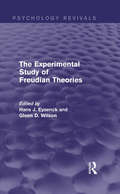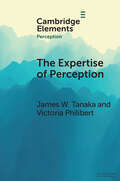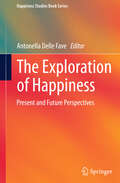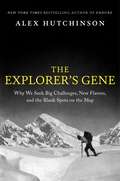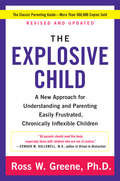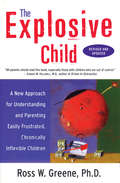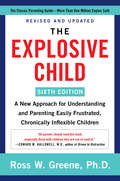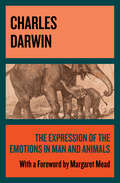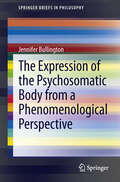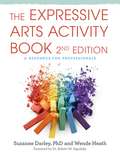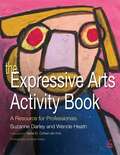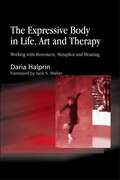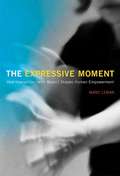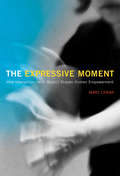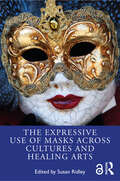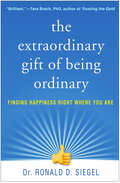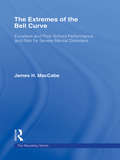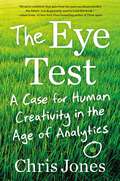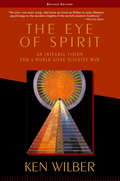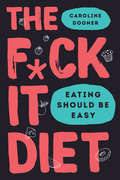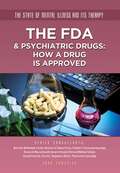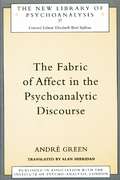- Table View
- List View
The Experimental Study of Freudian Theories (Psychology Revivals)
by Hans J. Eysenck and Glenn D. WilsonOriginally published in 1973 the editors of this book collected together those studies which had been considered at the time to yield the best evidence in support of Freudian theory, and found on close examination that they failed to provide any such proof. Each paper is printed in full and is followed by a critical discussion which raises questions of statistical treatment, sufficiency of controls and alternative interpretations. The particular usefulness of this format is that it allows readers to form their own opinions while providing helpful suggestions and guidelines on how to approach experimental studies with a critical mind.
The Expertise of Perception The Expertise of Perception: How Experience Changes the Way We See the World (Elements in Perception)
by James W. Tanaka Victoria PhilibertHow does experience change the way we perceive the world? This Element explores the interaction between perception and experience by studying perceptual experts, people who specialize in recognizing objects such as birds, automobiles, dogs. It proposes perceptual expertise promotes a downward shift in object recognition where experts recognize objects in their domain of expertise at a more specific level than novices. To support this claim, it examines the recognition abilities and brain mechanisms of real-world experts. It discusses the acquisition of expertise by tracing the cognitive and neural changes that occur as a novice becomes an expert through training and experience. Next, it looks “under the hood” of expertise and examines the perceptual features that experts bring to bear to facilitate their fast, accurate, and specific recognition. The final section considers the future of human expertise as deep learning models and artificial intelligence compete with human experts in medical diagnosis.
The Exploration of Happiness
by Antonella Delle FaveThis specially selected collection of landmark work from the Journal of Happiness Studies maps the current contours, and the likely future direction, of research in a field with a fast-rising profile. This volume, which inaugurates a series aiming to explore discrete topics in happiness and wellbeing studies, features selected articles published in the Journal of Happiness Studies during its first decade, which culminated in an 'impact factor' in 2011. As the introductory work in the series, it provides readers with a vital overview of the prominent issues, problems and challenges that well-being and happiness research has had to overcome since its appearance on the scientific stage. The journal's very success evinces both the high scientific quality of the research covered, and the steadily growing interest in a subject that draws responses from a vast range of epistemological aiming points, taking in economics, sociology, psychology, philosophy, education and medicine. The series of volumes following this debut publication will represent a unique contribution to the literature in their multidisciplinary focus on particularized topics. It is reckoned that this will help strengthen cross-disciplinary synergies among authors investigating the same topic, as well as whet the appetite for happiness research among professionals and experts inhabiting a variety of academic domains. This volume addresses the theory of well-being and happiness, the different research approaches now probing their features and components, and the socio-economic and cultural issues that impact on their promotion..
The Explorer's Gene: Why We Seek Big Challenges, New Flavors, and the Blank Spots on the Map
by Alex HutchinsonNew York Times-bestselling author of Endure Alex Hutchinson returns with a fresh, provocative investigation into how exploration, uncertainty, and risk shape our behavior and help us find meaning. Off the beaten path, following unmarked trails, we are wired to explore. More than just a need to get outside, the search for the unknown is a primal urge that has shaped the history of our species and continues to mold our behavior in ways we are only beginning to understand. In fact, the latest neuroscience suggests that exploration in any form—whether it’s trying a new restaurant, changing careers, or deciding to run a marathon—is an essential ingredient of human life. Exploration, it turns out, isn’t merely a hobby—it’s our story.In this much-anticipated follow-up to his New York Times bestseller Endure, Alex Hutchinson refutes the myth that, in our fully mapped digital world, the age of exploration is dead. Instead, the itch to discover new things persists in all of us, expressed not just on the slopes of Everest but in the ways we work, play, and live. From paddling the lost rivers of the northern Canadian wilderness to the ocean-spanning voyages of the Polynesians to the search for next-generation quantum computers, The Explorer’s Gene combines riveting stories of exploration with cutting-edge insights from behavioral psychology and neuroscience, making a powerful case that our lives are better—more productive, more meaningful, and more fun—when we break our habits and chart a new path.
The Explosive Child
by Ross W. GreeneScreaming, swearing, crying, hitting, kicking, spitting, biting...these are some of the challenging behaviors we see in kids who are having difficulty meeting our expectations. These behaviors often leave parents feeling frustrated, angry, overwhelmed, and desperate for answers. In this fully revised and updated book, Dr. Ross Greene helps you understand why and when your child does these things and how to respond in ways that are nonpunitive, nonadversarial, humane, and effective.Dr. Greene describes how best to: Understand the factors that contribute to challenging episodes. Identify the specific situations in which challenging episodes are likely to occur. Reduce or eliminate challenging episodes by solving the problems that cause them. Solve problems collaboratively (rather than unilaterally) and proactively (rather than reactively). Help your child develop the skills to be more flexible, solve problems, and handle frustration more adaptively. Reduce hostility and antagonism between you and your child.With Dr. Greene's practical, expert guidance, you and your child will forge a new relationship based on communication and mutual respect.
The Explosive Child
by Ross W. GreeneWhat's an explosive child? A child who responds to routine problems with extreme frustration-crying, screaming, swearing, kicking, hitting, biting, spitting, destroying property, and worse. A child whose frequent, severe outbursts leave his or her parents feeling frustrated, scared, worried, and desperate for help. Most of these parents have tried everything-reasoning, explaining, punishing, sticker charts, therapy, medication-but to no avail. They can't figure out why their child acts the way he or she does; they wonder why the strategies that work for other kids don't work for theirs; and they don't know what to do instead. Dr. Ross Greene, a distinguished clinician and pioneer in the treatment of kids with social, emotional, and behavioral challenges, has worked with thousands of explosive children, and he has good news: these kids aren't attention-seeking, manipulative, or unmotivated, and their parents aren't passive, permissive pushovers. Rather, explosive kids are lacking some crucial skills in the domains of flexibility/adaptability, frustration tolerance, and problem solving, and they require a different approach to parenting. Throughout this compassionate, insightful, and practical book, Dr. Greene provides a new conceptual framework for understanding their difficulties, based on research in the neurosciences. He explains why traditional parenting and treatment often don't work with these children, and he describes what to do instead. Instead of relying on rewarding and punishing, Dr. Greene's Collaborative Problem Solving model promotes working with explosive children to solve the problems that precipitate explosive episodes, and teaching these kids the skills they lack.
The Explosive Child [Sixth Edition]: A New Approach for Understanding and Parenting Easily Frustrated, Chronically Inflexible Children
by Ross W Greene PhDNow in a revised and updated 6th edition, the groundbreaking, research-based approach to understanding and parenting children who frequently exhibit severe fits of temper and other challenging behaviors, from a distinguished clinician and pioneer in the field.What’s an explosive child? A child who responds to routine problems with extreme frustration—crying, screaming, swearing, kicking, hitting, biting, spitting, destroying property, and worse. A child whose frequent, severe outbursts leave his or her parents feeling frustrated, scared, worried, and desperate for help. Most of these parents have tried everything-reasoning, explaining, punishing, sticker charts, therapy, medication—but to no avail. They can’t figure out why their child acts the way he or she does; they wonder why the strategies that work for other kids don’t work for theirs; and they don’t know what to do instead.Dr. Ross Greene, a distinguished clinician and pioneer in the treatment of kids with social, emotional, and behavioral challenges, has worked with thousands of explosive children, and he has good news: these kids aren’t attention-seeking, manipulative, or unmotivated, and their parents aren’t passive, permissive pushovers. Rather, explosive kids are lacking some crucial skills in the domains of flexibility/adaptability, frustration tolerance, and problem solving, and they require a different approach to parenting. Throughout this compassionate, insightful, and practical book, Dr. Greene provides a new conceptual framework for understanding their difficulties, based on research in the neurosciences. He explains why traditional parenting and treatment often don’t work with these children, and he describes what to do instead. Instead of relying on rewarding and punishing, Dr. Greene’s Collaborative Problem Solving model promotes working with explosive children to solve the problems that precipitate explosive episodes, and teaching these kids the skills they lack.
The Explosive Child: A New Approach for Understanding and Parenting Easily Frustrated, "Chronically Inflexible" Children
by Ross W. GreeneWhat's an explosive child? A child who responds to routine problems with extreme frustration-crying, screaming, swearing, kicking, hitting, biting, spitting, destroying property, and worse. A child whose frequent, severe outbursts leave his or her parents feeling frustrated, scared, worried, and desperate for help. Most of these parents have tried everything--reasoning, explaining, punishing, sticker charts, therapy, medication-- but to no avail. They can't figure out why their child acts the way he or she does; they wonder why the strategies that work for other kids don't work for theirs; and they don't know what to do instead. Dr. Ross Greene, a distinguished clinician and pioneer in the treatment of kids with social, emotional, and behavioral challenges, has worked with thousands of explosive children, and he has good news: these kids aren't attention-seeking, manipulative, or unmotivated, and their parents aren't passive, permissive pushovers. Rather, explosive kids are lacking some crucial skills in the domains of flexibility/adaptability, frustration tolerance, and problem solving, and they require a different approach to parenting. Throughout this compassionate, insightful, and practical book, Dr. Greene provides a new conceptual framework for understanding their difficulties, based on research in the neurosciences. He explains why traditional parenting and treatment often don't work with these children, and he describes what to do instead. Instead of relying on rewarding and punishing, Dr. Greene's Collaborative Problem Solving model promotes working with explosive children to solve the problems that precipitate explosive episodes, and teaching these kids the skills they lack.
The Expression of the Emotions in Man and Animals
by Charles DarwinWith a foreword by Margaret Mead: Darwin examines genetically determined behavior, combining the science of evolution with insights into human psychology.Published in 1872, thirteen years after On the Origin of Species, The Expression of the Emotions in Man and Animals is devoted to documenting what Darwin believes is the genetically determined aspects of behavior. Together with The Descent of Man (1871), it sketches out Darwin&’s main thesis of human origins. Here he traces the animal origins of human characteristics such as pursing of the lips in concentration, tightening of the muscles around the eyes in anger and efforts of memory. Darwin&’s thesis is that if the outward signs of behavior and emotions are shown to be universal in man and similar to animals then they must be due to inherited evolutionary adaptation, not culturally acquired characteristics. Several British psychiatrists, in particular James Crichton-Browne, were consultants for the book, which forms Darwin&’s main contribution to psychology. Darwin&’s collection of detailed observations along with his acute observational abilities and pictures (a landmark in the history of illustrations within the body of the text) corroborate his thesis and form the basis of the book. The foreword by Margaret Mead is of great interest in and of itself. Her foreword, illustrated with pictures provided by her, is designed to subvert Darwin&’s chief idea. Paul Ekman, a later editor of this same work, &“wonder[s] how Darwin would have felt had he known that his book was introduced by a cultural relativist who had included in his book pictures of those most opposed to his theory.&”
The Expression of the Psychosomatic Body from a Phenomenological Perspective
by Jennifer BullingtonThis book is a contribution to the understanding of psychosomatic health problems. Inspired by the work of the French phenomenologist Maurice Merleau-Ponty, a phenomenological theory of psychosomatics is worked out as an alternative to traditional, biomedical thinking. The patient who presents somatic symptoms with no clearly discernible lesion or dysfunction presents a problem to the traditional health care system. These symptoms are medically unexplainable, constituting an anomaly for the materialistic understanding of ill health that underlies the practice of modern medicine. The traditional biomedical model is not appropriate for understanding a number of health issues that we call "psychosomatic" and for this reason, biomedical theory and practice must be complemented by another theoretical understanding in order to adequately grasp the psychosomatic problematic. This book establishes a complementary understanding of psychosomatic ill health in terms of a non-reductionistic model allowing for the (psychosomatic) expression of the lived body. A thorough presentation of the work Merleau-Ponty is followed by the author's application of his thinking to the phenomenon of psychosomatic pathology.
The Expressive Arts Activity Book, 2nd edition: A Resource for Professionals
by Suzanne Darley Wende HeathThis new and updated book is packed full of tried-and-tested therapeutic activities for use in a range of care settings. It is designed to use simple and inexpensive tools and contains both individual and group activities of varying difficult, and includes real-life anecdotes that bring the techniques to life.
The Expressive Arts: A Resource For Professionals
by Gene D. Cohen Suzanne Darley Wende Heath<P><P>This resource comprises a collection of accessible, flexible, tried-and-tested activities for use with people in a range of care settings, to help them explore their knowledge of themselves and to make sense of their experiences. <P><P> Among the issues addressed by the activities are exploring physical changes, emotional trauma, interpersonal problems and spiritual dilemmas. Featuring individual and group activities of varying difficulty, including card making, painting to music, meditation, and body mapping, it also includes real-life anecdotes that bring the techniques to life. <P><P> The Expressive Arts Activity Book is full of fun, easy, creative ideas for workers in hospitals, clinics, schools, hospices, spiritual and religious settings, and in private practice.
The Expressive Body in Life, Art, and Therapy: Working with Movement, Metaphor and Meaning
by Daria HalprinDrawing on her extensive experience in expressive arts therapy, Daria Halprin presents a unique approach to healing through movement and art. She describes the body as the container of one's entire life experience and movement as a language that expresses and reveals our deepest struggles and creative potentials. Interweaving artistic and psychological processes, she offers a philosophy and methodology that invites the reader to consider the transformational capacity of the arts. In this essential resource for anyone interested in the integration of psychotherapy and the arts, Halprin also presents case studies and a selection of exercises that she has evolved over her career and practised at the Tamalpa Institute for over twenty-five years.
The Expressive Moment: How Interaction (with Music) Shapes Human Empowerment
by Marc LemanThe expressive moment is that point in time when we grasp a situation and respond quickly, even before we are aware of it. In this book, Marc Leman argues that expression drives this kind of interaction, and he proposes a general framework for understanding expressive interactions. He focuses on the dynamic, fast, and pre-reflective processes underlying our interactions with music -- whether we are playing an instrument, dancing, listening, or using new interactive technologies. Music offers a well-established domain for studying these fast and interactive processes, and Leman argues that understanding the power of expressive interaction through music may help us understand cognitive processing in other domains, including language, human action coordination, human-animal interaction, and human-machine interaction.Leman regards expressive interactions with music as energizing and empowering. He argues that music is based on patterns that intervene with a reinforcing loop in the human brain, strengthening learning, motivation, and reward. He argues further that the reinforcing effect is influenced by the interaction flow, by fast processes that handle expressive qualities on the fly.Leman sets out the framework in which expressive interaction is situated, describing, among other things, a pragmatic model of communication in which the fundamental components are enactment and dynamics. He looks in more detail at the cognitive-motivational architecture, discussing sensorimotor and motivational schemes. Finally, he discusses applications for the concepts behind expressive motivation in such fields as sports, entertainment, rehabilitation, multimedia art, and music education.
The Expressive Moment: How Interaction (with Music) Shapes Human Empowerment
by Marc LemanA new way to understand expressive interaction, focusing on the dynamic, fast, pre-reflective processes underlying interactions with music.The expressive moment is that point in time when we grasp a situation and respond quickly, even before we are aware of it. In this book, Marc Leman argues that expression drives this kind of interaction, and he proposes a general framework for understanding expressive interactions. He focuses on the dynamic, fast, and pre-reflective processes underlying our interactions with music—whether we are playing an instrument, dancing, listening, or using new interactive technologies. Music offers a well-established domain for studying these fast and interactive processes, and Leman argues that understanding the power of expressive interaction through music may help us understand cognitive processing in other domains, including language, human action coordination, human-animal interaction, and human-machine interaction.Leman regards expressive interactions with music as energizing and empowering. He argues that music is based on patterns that intervene with a reinforcing loop in the human brain, strengthening learning, motivation, and reward. He argues further that the reinforcing effect is influenced by the interaction flow, by fast processes that handle expressive qualities on the fly.Leman sets out the framework in which expressive interaction is situated, describing, among other things, a pragmatic model of communication in which the fundamental components are enactment and dynamics. He looks in more detail at the cognitive-motivational architecture, discussing sensorimotor and motivational schemes. Finally, he discusses applications for the concepts behind expressive motivation in such fields as sports, entertainment, rehabilitation, multimedia art, and music education.
The Expressive Use of Masks Across Cultures and Healing Arts
by Susan RidleyThe Expressive Use of Masks Across Cultures and Healing Arts explores the interplay between masks and culture and their therapeutic use in the healing arts such as music, art, dance/movement, drama, play, bibliotherapy, and intermodal.Each section of the book focuses on a different context, including viewing masks through a cultural lens, masks at play, their role in identity formation (persona and alter ego), healing the wounds from negative life experiences, from the protection of medical masks to helping the healing process, and from expressions of grief to celebrating life stories. Additionally, the importance of cultural sensitivity, including the differences between cultural appreciation and appropriation, is explored. Chapters are written by credentialed therapists to provide unique perspectives on the personal and professional use of masks in the treatment of diverse populations in a variety of settings. A range of experiences are explored, from undergraduate and graduate students to early professionals and seasoned therapists.The reader will be able to adapt and incorporate techniques and directives presented in these chapters. Readers are encouraged to explore their own cultural heritage, to find their authentic voice, as well as learn how to work with clients who have different life experiences. Chapter 3 of this book is freely available as a downloadable Open Access PDF at http://www.taylorfrancis.com under a Creative Commons [Attribution-Non Commercial-No Derivatives (CC-BY-NC-ND)] 4.0 license.
The Extended Mind: The Power of Thinking Outside the Brain
by Annie Murphy PaulA bold new book reveals how we can tap the intelligence that exists beyond our brains—in our bodies, our surroundings, and our relationshipsUse your head. That&’s what we tell ourselves when facing a tricky problem or a difficult project. But a growing body of research indicates that we&’ve got it exactly backwards. What we need to do, says acclaimed science writer Annie Murphy Paul, is think outside the brain. A host of &“extra-neural&” resources—the feelings and movements of our bodies, the physical spaces in which we learn and work, and the minds of those around us— can help us focus more intently, comprehend more deeply, and create more imaginatively. The Extended Mind outlines the research behind this exciting new vision of human ability, exploring the findings of neuroscientists, cognitive scientists, psychologists, and examining the practices of educators, managers, and leaders who are already reaping the benefits of thinking outside the brain. She excavates the untold history of how artists, scientists, and authors—from Jackson Pollock to Jonas Salk to Robert Caro—have used mental extensions to solve problems, make discoveries, and create new works. In the tradition of Howard Gardner&’s Frames of Mind or Daniel Goleman&’s Emotional Intelligence, The Extended Mind offers a dramatic new view of how our minds work, full of practical advice on how we can all think better.
The Extraordinary Gift of Being Ordinary: Finding Happiness Right Where You Are
by Ronald D. Siegel&“Did I sound stupid?&” &“Should I have sent that email?&” &“How do I look?&” Many of us spend a lot of time feeling self-conscious and comparing ourselves to others. Why do we judge ourselves so relentlessly? Why do we strive so hard to be special or successful, or to avoid feeling rejected? When psychologist and mindfulness expert Dr. Ronald Siegel realized that he, as well as most of his clients, was caught in a cycle of endless self-evaluation, he decided to do something about it. This engaging, empowering guide sheds light on this very human habit/m-/and explains how to break it. Through illuminating stories and exercises, practical tools (which you can download and print for repeated use), and guided meditations with accompanying audio downloads, Dr. Siegel invites you to stop obsessing so much about how you measure up. Instead, by accepting the extraordinary gift of being ordinary, you can build stronger connections with others and get more joy out of life.
The Extremes of the Bell Curve: Excellent and Poor School Performance and Risk for Severe Mental Disorders (Maudsley Series)
by James H. MacCabeIt has long been claimed that there is a strong association between high intelligence, or exceptional creativity, and mental illness. In this book, James MacCabe investigates this claim, using evidence from Swedish population data. He finds evidence that children who achieve either exceptionally high, or very low grades at school, are at greater risk of adult mental health disorders. This book opens with an introduction to the epidemiology of psychosis with particular emphasis on cognitive performance and creativity. It goes on to provide a detailed description of the rationale, methods and results of a population study involving nearly a million individuals, conducted by Dr MacCabe in collaboration with colleagues in Stockholm, Sweden, and London, UK. The Extremes of the Bell Curve will be of interest to mental health professionals including psychologists, psychiatrists and epidemiologists. It will also prove useful to those working in education.
The Eye Test: A Case for Human Creativity in the Age of Analytics
by Chris JonesIn a world increasingly ruled by numbers and algorithms, award-winning journalist Chris Jones makes a compelling case for a more personal approach to analytical thinking. THE EYE TEST is a necessary course correction, a call for a more balanced, personal approach to problem-solving. Award-winning journalist Chris Jones makes the case for the human element—for what smart, practiced, devoted people can bring to situations that have proved resistant to analytics. Jones shares what he&’s learned from an army of extraordinary talents, including some of the best doctors, executives, athletes, meteorologists, magicians, designers, astrophysicists, and detectives in the world. There are lessons in their mastery.Of course, there is a place for numbers in decision-making. No baseball player should be judged by his jawline. But the analytics revolution sparked by Michael Lewis&’s Moneyball now threatens to replace one kind of absurdity with another. We have developed a blind faith in the machine, the way a driver overly reliant on his GPS might be led off the edge of a cliff. Not all statistical analysis is sound. Algorithms aren&’t infallible, and spreadsheets aren&’t testaments. Trust in them too much, and they risk becoming instruments of destruction rather than understanding.Worse, data&’s supremacy in our daily lives has led to a dangerous strain of anti-expertise: the belief that every problem is a math problem, and anyone given access to the right information will find the right answer. That taste doesn&’t matter, experience doesn&’t matter, creativity doesn&’t matter. That we can&’t believe our eyes, no matter how much they&’ve seen. THE EYE TEST serves as a reminder that if beauty is less of a virtue in the age of analytics, a good eye still is. This book is a celebration of our greatest beholders—and an absorbing, inspiring guide for how you might become one, too.
The Eye of Spirit: An Integral Vision for a World Gone Slightly Mad
by Ken WilberIn this groundbreaking book, Ken Wilber uses his widely acknowledged "spectrum of consciousness" model to completely rewrite our approach to such important fields as psychology, spirituality, anthropology, cultural studies, art and literary theory, ecology, feminism, and planetary transformation. What would each of those fields look like if we wholeheartedly accepted the existence of not just body and mind but also soul and spirit? In a stunning display of integrative embrace, Wilber weaves these various fragments together into a coherent and compelling vision for the modern and postmodern world.
The F*ck It Diet: Eating Should Be Easy
by Caroline Dooner“The F*ck It Diet is not only hilarious, it is scientifically and medically sound. A must read for any chronic dieter.” –Christiane Northrup, MD, New York Times bestselling author of Women’s Bodies, Women’s Wisdom”From humorist and ex-diet junkie Caroline Dooner, an inspirational guide that will help you stop dieting, reboot your relationship with food, and regain your personal powerDIETING DOESN’T WORKNot long term. In fact, our bodies are hardwired against it. But each time our diets fail, instead of considering that maybe our ridiculously low-carb diet is the problem, we wonder what’s wrong with us. Why can’t we stick to our simple plan of grapefruit and tuna fish??? Why are we so hungry? What is wrong with us??? We berate ourselves for being lazy and weak, double down on our belief that losing weight is the key to our everlasting happiness, and resolve to do better tomorrow. But it’s time we called a spade a spade: Constantly trying to eat the smallest amount possible is a miserable way to live, and it isn’t even working. So fuck eating like that. In The F*ck It Diet, Caroline Dooner tackles the inherent flaws of dieting and diet culture, and offers readers a counterintuitively simple path to healing their physical, emotional, and mental relationship with food. What’s the secret anti-diet? Eat. Whatever you want. Honor your appetite and listen to your hunger. Trust that your body knows what it is doing. Oh, and don’t forget to rest, breathe, and be kind to yourself while you’re at it. Once you get yourself out of survival mode, it will become easier and easier to eat what your body really needs—a healthier relationship with food ultimately leads to a healthier you.An ex-yo-yo dieter herself, Dooner knows how terrifying it can be to break free of the vicious cycle, but with her signature sharp humor and compassion, she shows readers that a sustainable, easy relationship with food is possible.Irreverent and empowering, The F*ck It Diet is call to arms for anyone who feels guilt or pain over food, weight, or their body. It’s time to give up the shame and start thriving. Welcome to the F*ck It Diet. Let’s Eat.
The FDA & Psychiatric Drugs: How a Drug Is Approved (The State of Mental Illness and Its Ther)
by Joan EsherickImagine taking a medication meant to heal you only to discover that the drug rotted your bones, made your teeth fall out, and filled you with a radioactive element called radium. Pittsburgh industrialist Eben Byers didn't have to imagine. It happened to him, and he died as a result. Mr. Byers fell victim to "patent medicines" sold in the early twentieth century. Patent medicine quackery and other medical tragedies prompted the United States government to form an agency that could protect patients and consumers from mislabeled or dangerous medicines, cosmetics, and foods. That agency is the U.S. Food and Drug Administration (FDA). Most drugs and medical treatments sold in North America today, including drugs used to treat psychological disorders, are regulated by this consumer protection agency. Many people diagnosed with depression, panic attacks, schizophrenia, ADHD, and other psychological disorders lead normal lives because they are treated with psychiatric drugs approved by the FDA. But what are psychiatric drugs? Where do they come from? How do they work? What does it take for the FDA to approve them? Why do we have the FDA? Perhaps most important, does FDA approval guarantee safety? Loaded with case studies and user-friendly illustrations, this readable text answers these and other questions as it examines a brief history of mental disorders and their treatment. In its pages, you will learn about the origins of the FDA, the FDA drug approval process, the structure and chemistry of the brain, psychiatric drugs and how they work, adverse reactions, and alternative treatments. Come learn about the drug approval process. Next time you reach into your medicine cabinet, you'll be glad you did.
The Fabric of Affect in the Psychoanalytic Discourse (New Library of Psychoanalysis #No.38)
by Andre GreenThe Fabric of Affect in the Psychoanalytic Discourse is a seminal work on one of the most neglected topics in psychoanalysis, that of affect. Originally published in French as Le Discours Vivant, and by one of the most distinguished living analysts, the book is structured in three parts: Affect within psychoanalytic literature Clinical practice of psychoanalysis: structure and process Theoretical study: affect, language and discourse; negative hallucination Written in a clear, lucid style, connecting theory to both culture and clinical practice, this book will appeal to psychoanalysts and psychotherapists, and also to those involved in cultural studies.
